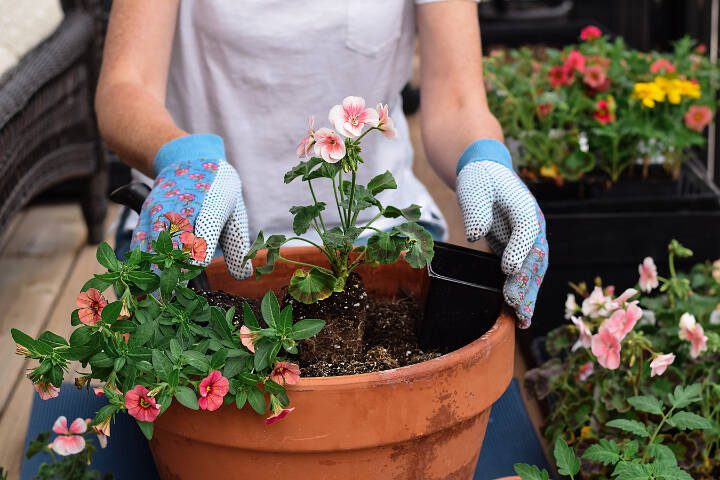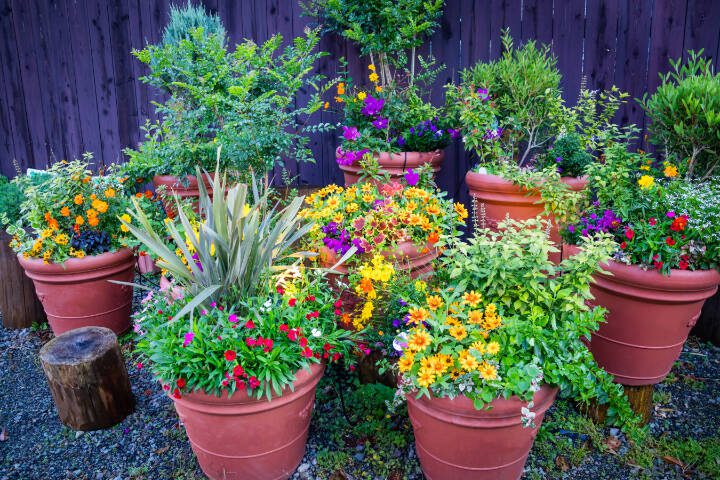By Trevor Cameron / The Golfing Gardener
Now that temperatures have risen and we are heading toward the warmth of summer, it’s the ideal time to add colorful containers to our decks, patios, porches and landscapes.
For many gardeners like me, this involves rejuvenating existing ones by sprucing them up with plants that will add flower power from now until the frost comes in fall. This may also mean looking for new, quality, frost-proof pots and creating fresh designs.
Whenever I talk container design, I always start with three components: the thriller, the filler and the spiller. Deciding what will fill these roles is up to you, and it’s an opportunity to have fun; I can certainly tell you what I like, but ultimately the foliage and flowers you choose must match your own taste.
The thriller: What will the centerpiece of interest be? Since almost anything can be grown in a pot, the options here are endless: something permanent such as a Japanese maple, dwarf conifer, grass or small shrub; or a fun, seasonal item such as a dahlia, canna lily or salvia; or maybe a show-stopping foliage plant such as coleus.
The filler: What will fill the space around the thriller, providing contrast and color? Again, the options are plentiful, both for foliage items such as the heucheras and grasses I tend to use, or annuals such as impatiens, zinnias, begonias and geraniums.
The spiller: What will trail or spill over the sides a bit, softening the container edge and providing additional color and contrast? Again, there are lots of options, including permanent plants such as Creeping Jenny, variegated ivy and trailing euonymus, or even more annuals such as lobelia, million bells, verbenas, torenias and nemesias.
Now, being OCD myself, I admittedly go matchy-matchy a little too much, but there are certainly spots for this, such as either side of the garage door or the porch, for example. Personally I gravitate toward the hotter yellows, oranges, reds and purples. This may not be your thing, however, and pastels can certainly be just as attractive. I try to break out of my mold these days and not do the same thing year after year, like I used to. The key word here is try.
Here are some general tips to help guide you to successful container gardens:
• Always use a quality, well-draining organic potting soil. Keep in mind that tired soil means tired plants, so old soil should not be kept and fresh should be added each year. Be careful with “moisture control” mixes, as sometimes they can hold too much moisture.
• When planting, mix an organic rose flower food and organic Ultra Bloom into the soil to set the stage for a season of success.
• Remember that things don’t have to be packed so tightly that you cannot see soil. Give them room to grow, meander and mature. An over-planted container will get tired and need more watering.
• Fertilize regularly to keep things thriving and blooming. Do this once every two weeks with a water-soluble product such as Sea Grow. This acts as a foliar food and filters into the soil for the roots, as well.
• Many plants can serve multiple purposes; one container’s thriller could be another’s filler. For example, a small pot may have a heuchera as a thriller, while a large pot may use these as fillers or even spillers.
• Flowers are always showy, but look for interest from foliage, as well. Often, variegated, golden, limey chartreuse or even dark foliage will really pop when mixed with greens and various flower colors.
• Always plant like with like (sun with sun, shade with shade) and consider watering needs, as well (dry with dry, wet with wet).
• Be careful not to overwater, especially when newly planted. Check regularly for watering needs, keeping in mind that the top may look dry but the soil 2 to 3 inches down may still be moist.
• As the summer progresses, larger plants mean more roots and less soil, so check watering needs more often, especially in sun.
• If you are using somewhat permanent plants, add soil all the way to the bottom and do not use spacers or fillers. If you have a large, deep pot and are just using seasonal flowers, sometimes an ‘Ups-A-Daisy’ spacer will help save soil. These are inserted into the container and create a hollow bottom, allowing you to only fill the top portion with potting soil.
• When placing your containers on a hard surface (such as wood or concrete), use pot risers or pot feet to elevate them a bit, ensuring drainage and eliminating the pot’s footprint staining the ground.
Size matters in the world of container gardening. Designs can be simple and still striking, orthey can be large, bold and intricate. A small pot can be just as impactful as a large one, but the larger the pot, the more opportunity to mix things up and use more permanent plants.
Personally, I add annual color to all my pots — a few are even 100% annuals. Most, however, incorporate annual color in addition to thrillers and fillers that I can leave potted for years. Often, these plants can then be recycled into the garden at some point, which is perfect for feeding my insatiable appetite for more plants. As a frugal gardener, I can then spend a little less on flowers each season and, instead of redoing the entire pot, I can leave the hardier perennial, shrub or small tree that is already in place, adding only the color I crave to make the container pop for another season.
Almost all gardeners have empty pots behind the house that can be put to use. Others, like me, continue to find places to add a new container, creating a perfect excuse to buy another cool pot. Either way, containers are a fun way to create a personal prize, a mini landscape in some respects, that represents the style and color that speaks you.
Free class
Sunnyside Nursery in Marysville will host “Thrillers, Fillers & Spillers” at 10 a.m. on Saturday, May 25. For more information or to sign up, go to www.sunnysidenursery.net/classes.
Trevor Cameron is a certified professional horticulturist (CPH) and serves as general manager for Sunnyside Nursery in Marysville. He can be reached at sunnysidenursery@msn.com.
Talk to us
> Give us your news tips.
> Send us a letter to the editor.
> More Herald contact information.


























